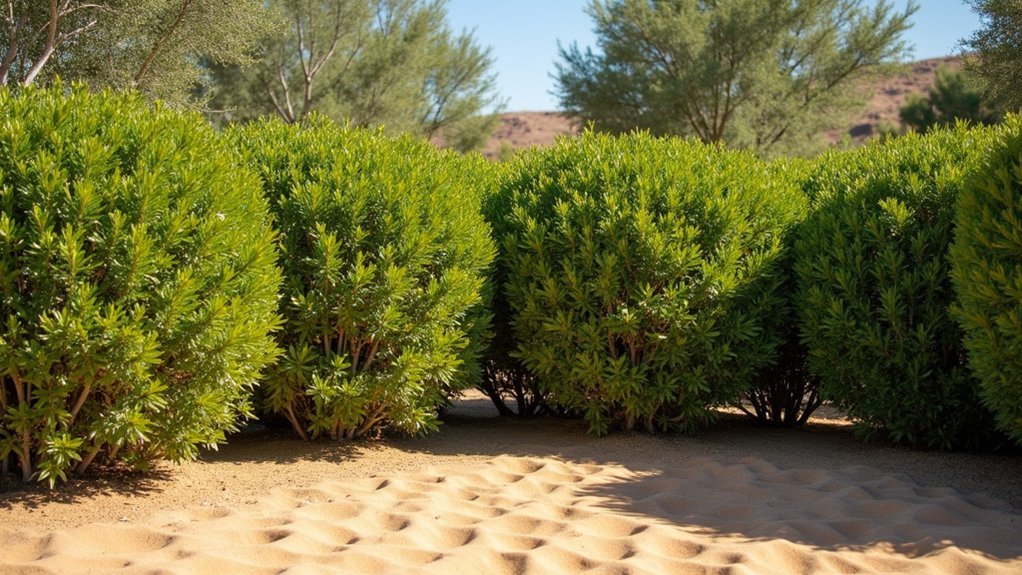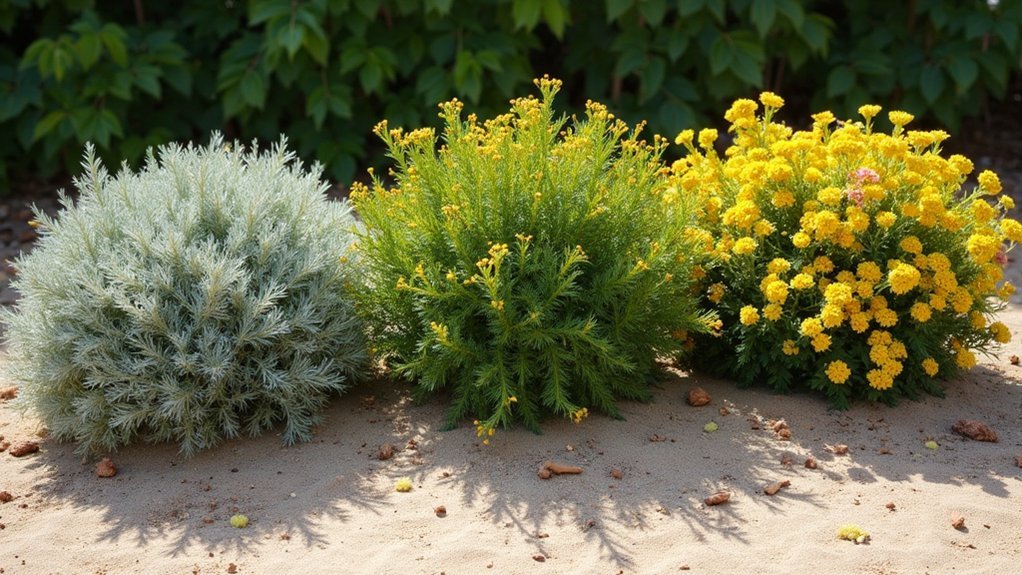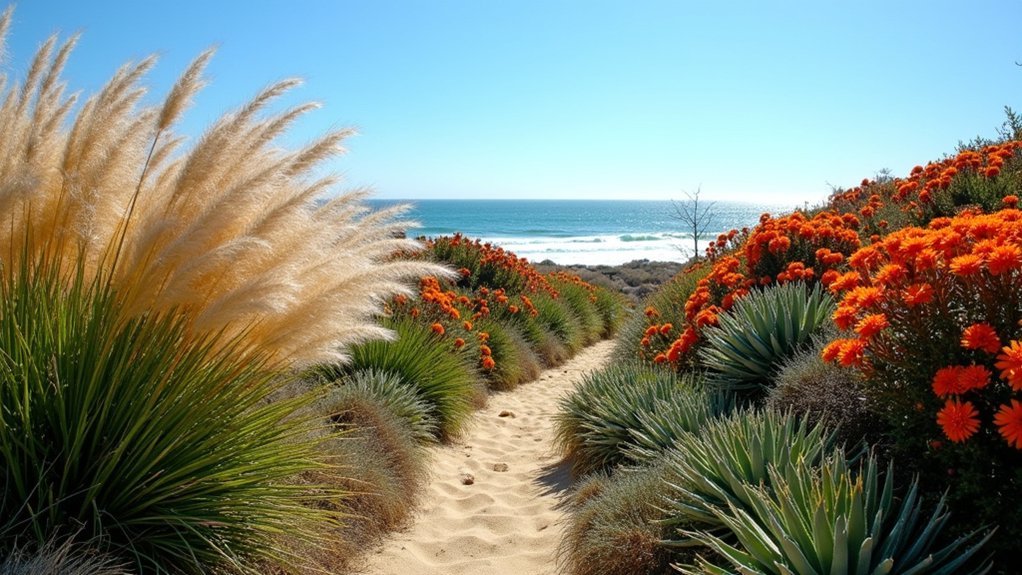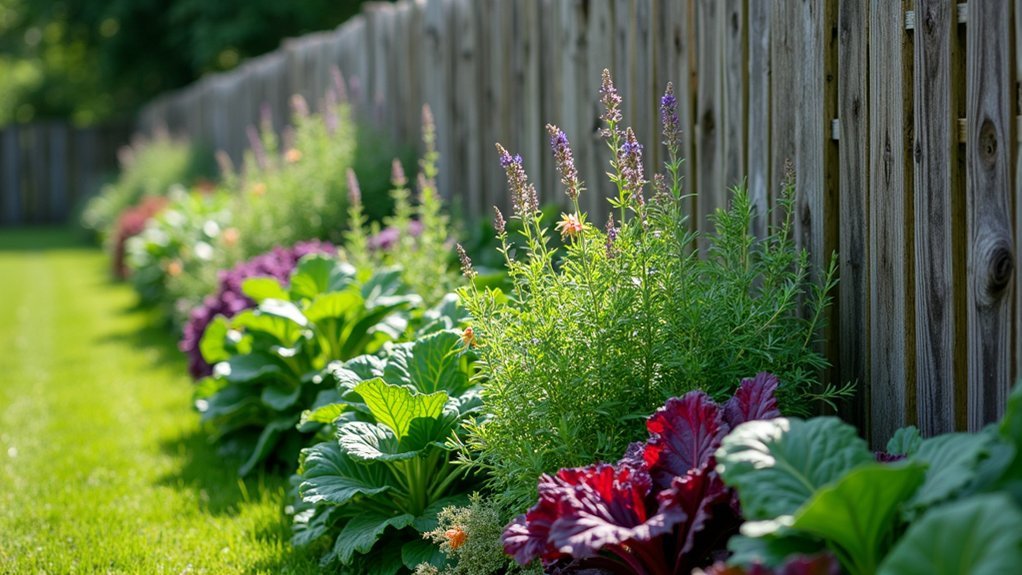The three best shrubs for sandy soil fencing are Ninebark, Hedge Cotoneaster, and Upright Junipers. You’ll love how Ninebark thrives with minimal water once established, while Hedge Cotoneaster grows to 6-10 feet with proper pruning. Upright Junipers like Blue Point excel in full sun and sandy conditions, creating natural screens. These drought-resistant options require little maintenance after their establishment phase. The following varieties offer both practical solutions and aesthetic appeal for your challenging soil conditions.
Drought-Resistant Hedge Options for Sandy Conditions

While sandy soil presents challenges for many plants, several shrub varieties thrive in these conditions and make excellent hedges for privacy and windbreaks.
Ninebarks are standout drought-resistant options that grow well in sandy environments, requiring minimal water once established.
For full sun locations, consider upright junipers like Blue Point and Wichita Blue, which excel in sandy soil while providing dense hedging.
Hedge cotoneaster offers versatility, reaching 6-10 feet with proper pruning for a tidy appearance.
Colorful barberry varieties combine drought resistance with visual appeal, creating low-maintenance hedges for sandy conditions.
Don’t overlook lavenders, which not only tolerate sandy soil but provide fragrance and beauty as hedging plants.
Adding organic matter during planting helps these hedges for sandy areas establish more quickly while maintaining their drought-tolerant nature.
Native Shrub Varieties That Thrive in Poor Soil
Because sandy soils challenge many plants with their quick drainage and low nutrient content, choosing native shrubs specifically adapted to these conditions guarantees a successful fence or hedge.
Sandy soil gardening success relies on selecting native plants already adapted to survive nutrient-poor, fast-draining conditions.
These indigenous hedging plants have evolved to capture water and nutrients efficiently in poor soil environments.
Consider these native shrubs for suitable hedging in sandy soils:
- Ninebark (Physocarpus) – Offers attractive foliage and flowers while withstanding drought conditions with minimal care.
- Hedge Cotoneaster (Cotoneaster lucidus) – Provides seasonal interest with fall coloration and remarkable hardiness in harsh environments.
- Butterfly Weed (Asclepias tuberosa) – Thrives in well-drained sandy soils while attracting pollinators, making it both beautiful and ecologically valuable.
For additional color options, Barberry varieties deliver vibrant foliage and berries while tolerating the challenging conditions that sandy soils present.
Creating Privacy Boundaries With Sandy Soil Specialists

Since privacy remains a top priority for many homeowners, establishing effective boundaries in sandy soil requires selecting specialized shrubs that embrace these challenging conditions.
Drought-tolerant options like Hedge Cotoneaster and Ninebarks thrive in well-drained sandy environments, creating dense privacy hedges without demanding excessive care.
Upright junipers, particularly Blue Point and Ames varieties, excel in sandy soil and full sun exposure, making them perfect natural screens.
To improve moisture retention, incorporate organic matter such as compost before planting. This simple step enhances nutrient density and supports healthier growth.
Don’t overlook native plant species like Butterfly Weed and Black Eyed Susan, which not only flourish in sandy conditions but also attract beneficial wildlife.
Remember to water your plants regularly during their establishment phase, as sandy soil drains quickly.
Frequently Asked Questions
What Is the Best Hedge for Sandy Soil?
For sandy soil, you’ll find Hedge Cotoneaster and Ninebark varieties like Diablo work best. They’re drought-tolerant and thrive in low-nutrient conditions. Upright Junipers and flowering Spiraea also perform exceptionally well in sandy environments.
Which Plant Can Grow Best in Sandy Soil?
You’ll find several plants thrive in sandy soil. Hedge cotoneaster, ninebarks like Diablo, upright junipers, and barberry are excellent choices. They’re drought-tolerant and don’t mind the quick-draining conditions sandy soil provides.
What Is the Best Bush to Use as a Fence?
For a natural fence, you’ll find English Yew is your best option. It’s drought-tolerant and can be shaped precisely. Hedge cotoneaster also works well, growing 6-10 feet tall and forming dense barriers when pruned.
What Is the Best Ground Cover Plant for Sandy Soil?
For sandy soil, you’ll find Creeping Thyme and Sedum excellent ground covers. They’re drought-tolerant and thrive in poor conditions. Lavender and Beach Strawberry also work well, offering fragrance and edible fruits respectively.
In Summary
You’ve discovered that sandy soil doesn’t mean you can’t have beautiful hedges. By choosing drought-resistant options like Juniper, native varieties such as Bayberry, or privacy specialists like Russian Olive, you’ll create stunning boundaries that thrive in challenging conditions. Remember to water deeply but infrequently when establishing your new plants, and you’ll enjoy these low-maintenance fence shrubs for years to come.





Leave a Reply